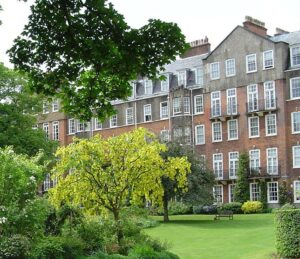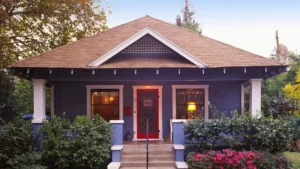In the heart of downtown Los Angeles, on an unassuming corner of South Broadway and Third Street, stands a building that has intrigued architects, filmmakers, and tourists alike for over a century—the Bradbury Building. Its origin story reads like a blend of ambition and whimsy. In the late 19th century, Lewis L. Bradbury, a mining millionaire with little experience in real estate, decided to commission a building that would serve as a statement of his wealth and vision. After rejecting the plans of a reputable architect, Bradbury turned to George Wyman, a young draftsman with no significant portfolio. Legend has it that Wyman, hesitant to accept such a monumental project, consulted an Ouija board, which reportedly spelled out the words, “Take Bradbury Building. It will make you famous.” The rest, as they say, is history.
A Masterpiece Born from Ambition
Completed in 1893, the Bradbury Building is one of the oldest commercial buildings in Los Angeles and one of the most iconic. It was unlike anything the city had ever seen when it opened. Its modest Romanesque exterior, designed with brown brick and sandstone, concealed the architectural wonder inside. Stepping through its wooden doors, visitors were—and still are—greeted by a grand five-story atrium flooded with natural light. Iron railings intricately designed with French and Italian influences line the walkways, and open-cage elevators with wrought-iron detailing ascend gracefully to the top floors.
According to the Los Angeles Conservancy, the building was constructed for $500,000, a considerable sum at the time. It was an ambitious project for Wyman, who combined styles and materials to create a unique blend of old-world craftsmanship and forward-thinking design.
Design and Architectural Details
The Bradbury Building is most captivating feature is its interior. The main atrium is illuminated by a skylight made of glass and iron, which bathes the space in natural light and gives it an almost ethereal quality. The staircases, cast in wrought iron and detailed with exquisite scrollwork, spiral upward, creating a sense of movement and elegance. The floors are paved with Mexican tile, and the landings are adorned with Belgian marble, all contributing to a luxurious and timeless experience.
Fact Check: According to the U.S. National Register of Historic Places, the design was inspired by Edward Bellamy’s 1888 science fiction novel Looking Backward, which described a futuristic building with an open atrium surrounded by balconies. This vision resonated with George Wyman, who brought it to life with a skill that belied his lack of formal training.
A Cultural Landmark
The Bradbury Building has been more than just an architectural gem throughout its existence—it has become a cultural landmark. In 1971, it was designated a Los Angeles Historic-Cultural Monument, and later, in 1977, it earned a place on the National Register of Historic Places. The building’s unique design and cinematic quality have made it a popular filming location. Perhaps its most famous appearance was in the 1982 film Blade Runner, where its futuristic yet retro aesthetic perfectly suited the film’s neo-noir atmosphere.
Other notable films and TV shows that have featured the Bradbury Building include 500 Days of Summer, The Artist, and episodes of Perry Mason and The Outer Limits. This cultural legacy has added layers of charisma and fame, turning the Bradbury into a must-see for visitors and a beloved icon for Los Angeles locals.
Stats and Notable Facts
- Construction Year: Completed in 1893.
- Cost: Approximately $500,000 in 1893 dollars, equivalent to about $15 million today.
- Height: Five stories with a central atrium that extends upward.
- Design Influence: Inspired by Edward Bellamy’s novel Looking Backward.
- Historical Designation: It became a Los Angeles Historic-Cultural Monument in 1971 and was listed on the National Register of Historic Places in 1977.
- Famous Films: Blade Runner, 500 Days of Summer, and The Artist.
Source: Data from the Los Angeles Conservancy and the U.S. National Register of Historic Places.
The Challenges of Preservation
Preserving a building as intricate and historic as the Bradbury Building comes with challenges. Maintaining the integrity of the original materials, such as the ironwork and marble, requires specialized conservation efforts. Over the years, various restoration projects have aimed to maintain its original splendor. For example, a major restoration in the 1990s ensured that the skylights, elevators, and iron railings were returned to their former glory while modernizing aspects like electrical wiring and plumbing.
Architectural Conservation Expert Mark Hughes notes that “maintaining a building like the Bradbury is like caring for a living piece of history. Each repair or restoration must be meticulously planned to preserve the aesthetic and historical value.”
Why the Bradbury Building Matters Today
The Bradbury Building is a testament to a time when architecture was as much about art as it was about function. In an era dominated by steel-and-glass skyscrapers, this five-story marvel serves as a reminder that beauty, craftsmanship, and innovation are timeless. It’s more than just a building; it’s a piece of Los Angeles’ soul, encapsulating its city’s ambition and the ingenuity of the human spirit.
Moreover, it continues to attract visitors, from architecture students who come to study its unique design to film buffs eager to walk in the footsteps of their favorite characters. According to a 2022 report by Visit California, the Bradbury Building remains one of the top 20 most visited historical sites in Los Angeles, drawing over 100,000 visitors annually.
Conclusion: A Legacy of Vision and Artistry
The Bradbury Building is not just a relic of the past but a living, breathing piece of history that has adapted and endured through generations. The story of how it came to be—from Lewis L. Bradbury’s dream to George Wyman’s leap of faith—adds a rich layer of narrative that matches the building’s stunning visual impact. For over 130 years, it has stood as a monument to innovation, proving that sometimes the most extraordinary creations come from unexpected places.
As Los Angeles continues to evolve and change, the Bradbury Building stands resilient, offering a window into the city’s past and a reminder of the timelessness of inspired architecture. In a world constantly racing forward, this remarkable structure invites us to pause, look up, and appreciate the beauty of history preserved.






